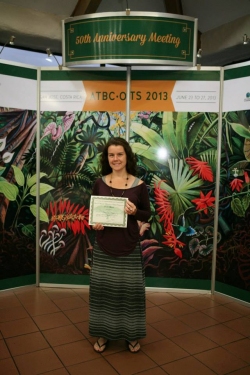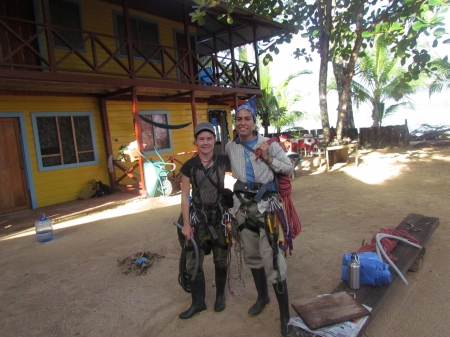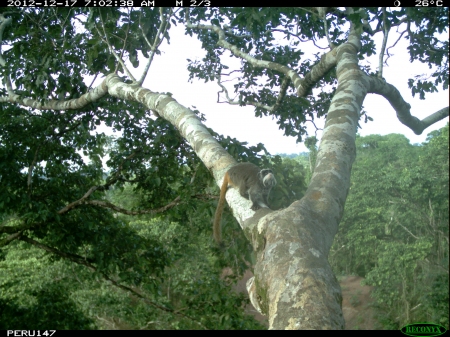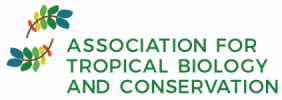The Luis F. Bacardi Award is given to a young post-doctoral researcher (no more than five years after completing Ph.D.) for outstanding conservation-related presentation at each ATBC annual meeting.
 The 2013 winner is Dr Tremaine (Tremie) Gregory. Her Ph D Dissertation was on the ecology of bearded saki monkey, Chiropotes sagulatus, at Brownsberg Natural Park, Suriname (see Marilyn Norconk’s Lab.) Today, she’s a research scientist at the Smithsonian Institute, USA, and developed a research program to maintaining natural movement of animals that live in the tropical rain canopy in South America. As development and resource extraction encroach on remote areas of the Amazon, the forest is becoming increasingly fragmented, limiting where animals that cannot fly and only live in trees can go. To find a solution, researchers at the Smithsonian Conservation Biology Institute convinced a development company to do an experiment. Researchers worked with company engineers to leave behind “natural canopy bridges,”standing trees with large branches that maintain connections between both sides of the forest. (Source: Smithsonian Science)
The 2013 winner is Dr Tremaine (Tremie) Gregory. Her Ph D Dissertation was on the ecology of bearded saki monkey, Chiropotes sagulatus, at Brownsberg Natural Park, Suriname (see Marilyn Norconk’s Lab.) Today, she’s a research scientist at the Smithsonian Institute, USA, and developed a research program to maintaining natural movement of animals that live in the tropical rain canopy in South America. As development and resource extraction encroach on remote areas of the Amazon, the forest is becoming increasingly fragmented, limiting where animals that cannot fly and only live in trees can go. To find a solution, researchers at the Smithsonian Conservation Biology Institute convinced a development company to do an experiment. Researchers worked with company engineers to leave behind “natural canopy bridges,”standing trees with large branches that maintain connections between both sides of the forest. (Source: Smithsonian Science)
Natural canopy bridges over a gas pipeline: a mitigation strategy for arboreal animals in Peru
Tremaine Gregory, Farah Carrasco Rueda, Jessica Deichmann, Joseph Kolowski, and Alfonso Alonso
Center for Conservation Education and Sustainability, Smithsonian Conservation Biology Institute, National Zoological Park
Contact: Gregoryt@si.edu

Placement of camera traps in a canopy bridge by Tremaine Gregory. Note the right-of-way for the natural gas pipeline below. © Farah Carrasco.
Abstract. Travel routes for arboreal animals are disrupted when the development of linear infrastructure (e.g. roads and pipelines) involves the fragmentation of the canopy. In the Neotropics, primates are highly arboreal, and a pipeline has the potential to divide populations, altering territories and interrupting important processes such as gene flow. Through a collaboration with a natural gas company, we are investigating the impact of the construction of a natural gas pipeline on primates in the Lower Urubamba Region of Perú, and testing a novel strategy to reduce the effects of canopy fragmentation. We are monitoring the distribution of primate groups within one kilometer of the pipeline right-of-way (RoW) with transect walks before, during, and after pipeline construction, and assessing whether RoW crossing frequency is influenced by the presence of natural canopy bridges, connections left between canopy branches above the pipeline where animals may cross.
Data collected during construction suggest a reduction in primate encounter rates within one kilometer of the RoW, as compared to before construction began. However, in the four months since the RoW was exposed, 8,000 camera trap photos show that all 13 natural bridges have been used by over 125 individuals of 19 arboreal mammal species. In contrast, where there are no natural bridges, only one of these arboreal species has been recorded crossing the RoW on the ground. This study highlights the value of collaborations between conservation organizations and development industries in proposing and documenting protocols for industry “best practices.” As we assess research priorities for the next 50 years and consider the increasing threat of human impacts on biodiversity, scientists must engage in developing, testing, and documenting strategies for impact mitigation.

Tremaine with co-author, Farah Carrasco, during tree climbing training for canopy camera placement. © Joe Maher.
More about Tremie Gregory’s research in the Amazon

Canopy camera trap photo of Saguinus imperator utilizing a canopy bridge at 33m in height. (© Tremaine Gregory)
There is much potential for hydrocarbon exploration in the Western Amazon. In 2012, 53% of the Peruvian Amazon was covered with concessions; yet, the Peruvian Amazon is also among the world’s most biodiverse areas. Nonetheless, little scientifically rigorous research has been performed to understand the impact of such activities on wildlife. Furthermore, while companies may strive to engage in best practices to reduce impact, many of the methods have not been scientifically tested. Tremie is leading a study measuring the impact of the construction of a natural gas pipeline on arboreal animals, which are expected to be heavily impacted by canopy fragmentation induced by the right-of-way (RoW, the swath cut for the pipeline, see photo). And, in turn, with camera traps she is testing the effectiveness of the best practice of leaving natural canopy bridges (branch crossing points over the RoW) in impact mitigation. Through a partnership with the pipeline construction company, Tremie and her team have been able to monitor the area before, during, and after construction activities.
Initial results of monitoring before and during pipeline construction suggest a decrease in primate group encounter rates, a possible sign that the construction process may impact primate distribution patterns. Upcoming monitoring of primate abundance after construction will provide information about whether this pattern continues over the long term or if animals return to the area. On the other hand, camera trap monitoring of natural canopy bridges provides initial evidence of their effectiveness in fragmentation mitigation, with photos of over 1,000 crossing events by 19 mammal species in the first six months of the study.
Recent Articles
- Norconk, M.A., Raghanti, M.A. Martin, S.K., Grafton, B.W., Gregory, L.T., and De Dijn, B.P.E.2003. Primates of Brownsberg Natuurpark, Suriname, with Particular Attention to the Pitheciins. Neotropical Primates 11(2):94-100. [PDF 174KB]
-
Tremaine Gregory (2011) Socioecology of the Guianan bearded saki, Chiropotes sagulatus. (PhD dissertation PDF 3.12MB) Website Marylin Norconk – ATBC2008.org
-
Gregory, T. and Norconk M.A. (2013). Comparative socioecology of sympatric, free-ranging white-faced and bearded saki monkeys in Suriname: A preliminary study. In: Evolutionary Biology and Conservation of Titis, Sakis, and Uacaris (L.M. Veiga, A.A. Barnett, S.F. Ferrari & M.A. Norconk, eds). Cambridge University Press, Cambridge
-
Gregory, T., Carrasco Rueda, F., Deichmann, J.L., Kolowski, J., and Alonso, A. (2013). Primates of the Lower Urubamba Region, Peru, with comments on other mammals. Neotropical Primates19(1):16-23.
-
Gregory, T., Carrasco Rueda, F., Deichmann, J., Kolowski, J., Costa Faura, M., Dallmeier, F., and Alonso, A. (2013). Methods to establish canopy bridges to increase natural connectivity in linear infrastructure development. Society of Petroleum Engineers SPE12LAHS-P-157.
-
Gregory, T., Mullett, A., and Norconk, M.A. (accepted). Strategies for navigating large areas: A GIS spatial ecology analysis of the bearded saki monkey, Chiropotes sagulatus, in Suriname.American Journal of Primatology.
-
Gregory, T., Carrasco Rueda, F., Deichmann, J.L., Kolowski, J., and Alonso, A. (in review). Cameras in the high canopy: Broadening horizons of arboreal wildlife monitoring. International Journal of Primatology.
-
Gregory, T. and Norconk, M.A. (in review). Bearded saki socioecology: Affiliative male-male interactions in large, free-ranging groups in Suriname. Behaviour.
Links
- Nighttime In The Rainforest Canopy
- Video of Tremie’s work: http://smithsonianscience.org/2013/05/natural-canopy-bridges-maintain-connections-in-the-forest/




